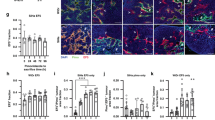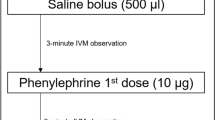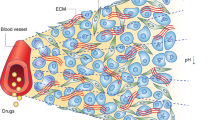Abstract
Studies of transplantable rodent tumours have suggested that malignant tissue might experience transient perfusion at the microvascular level. The purpose of the work reported here was to investigate whether transient perfusion can be demonstrated in xenografted human tumours. Tumours of four melanoma lines (A-07, D-12, R-18, U-25), grown orthotopically in Balb/c nu/nu mice, were included in the study. Transient perfusion was studied by using the double-fluorescent staining technique. Hoechst 33342 and DiOC7(3) were either administered simultaneously or Hoechst 33342 was administered 20 min before DiOC7(3). Detection of transient perfusion by this method requires that vessels are non-functional for at least 5 min owing to the distribution half-lives of the dyes in the blood. Usable combinations of dye concentrations were found by varying the concentrations of Hoechst 33342 and DiOC7(3) systematically. The level of perfusion mismatch following simultaneous administration of the dyes ranged from approximately 1.5% for U-25 tumours to approximately 3.0% for R-18 tumours at these combinations. Moreover, the fraction of vessels stained only with Hoechst 33342 and the fraction of vessels stained only with DiOC7(3) were not significantly different whether the dyes were administered simultaneously or sequentially. Transient perfusion could not be demonstrated in any of the tumour lines. Thus, the fraction of vessels stained only with Hoechst 33342 and the fraction of vessels stained only with DiOC7(3) were not significantly higher after sequential than after simultaneous administration of the dyes. Moreover, the vessels stained only with Hoechst 33342 and the vessels stained only with DiOC7(3) were randomly distributed within the tumours whether the dyes were administered simultaneously or sequentially. Consequently, acute hypoxia caused by transient perfusion is probably a less pronounced phenomenon in malignant tissue than previous studies of rodent tumours have suggested.
This is a preview of subscription content, access via your institution
Access options
Subscribe to this journal
Receive 24 print issues and online access
$259.00 per year
only $10.79 per issue
Buy this article
- Purchase on Springer Link
- Instant access to full article PDF
Prices may be subject to local taxes which are calculated during checkout
Similar content being viewed by others
Author information
Authors and Affiliations
Rights and permissions
About this article
Cite this article
Tufto, I., Rofstad, E. Transient perfusion in human melanoma xenografts. Br J Cancer 71, 789–793 (1995). https://doi.org/10.1038/bjc.1995.153
Issue Date:
DOI: https://doi.org/10.1038/bjc.1995.153
This article is cited by
-
Acute versus chronic hypoxia in tumors
Strahlentherapie und Onkologie (2012)
-
Quantitative assessment of hypoxia subtypes in microcirculatory supply units of malignant tumors Using (immuno-)fluorescence techniques
Strahlentherapie und Onkologie (2011)



